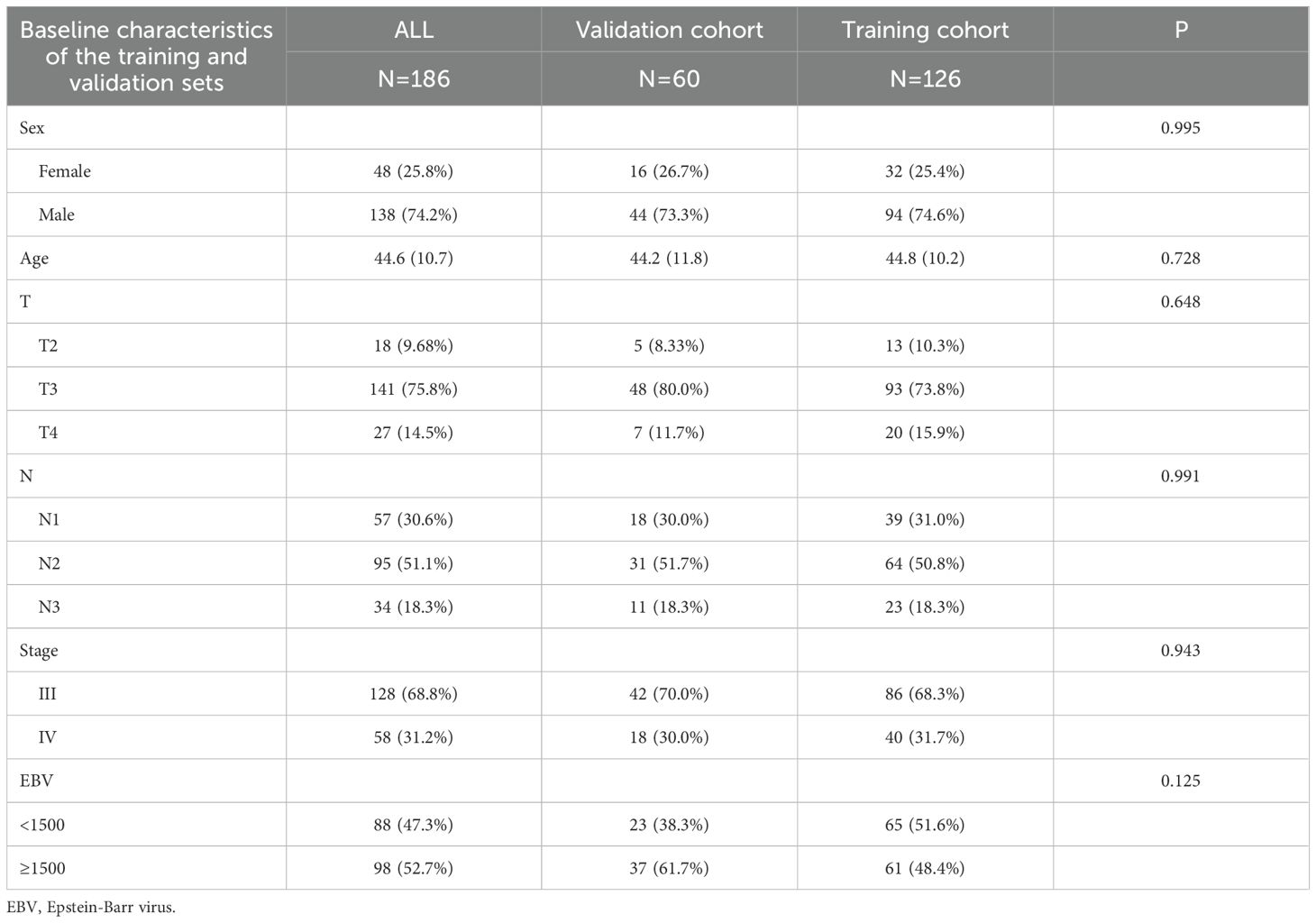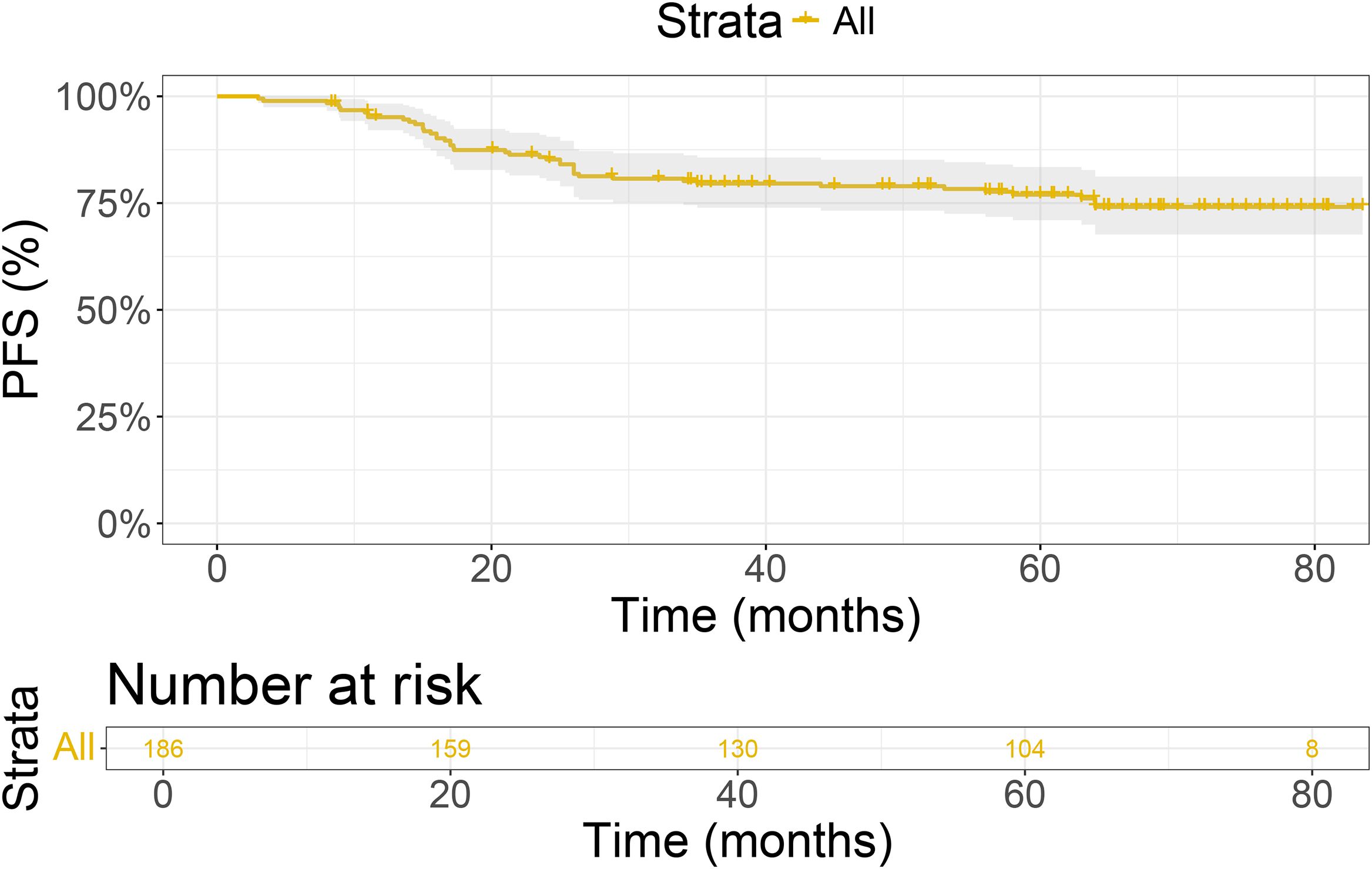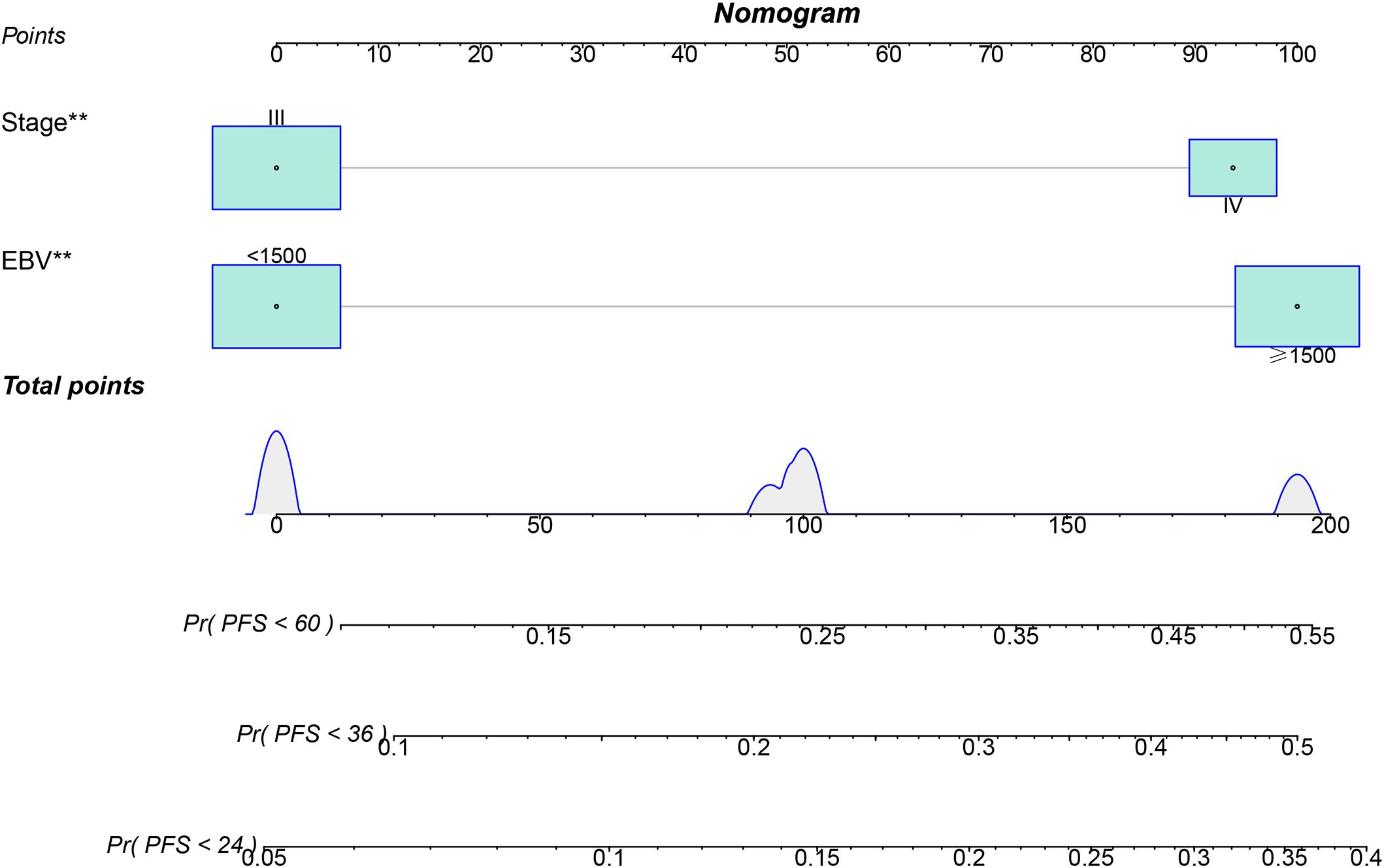- Department of Oncology, Luzhou People’s Hospital, Luzhou, China
Background: This retrospective study aimed to develop and validate a prognostic evaluation system based on the LASSO-Cox regression model for nasopharyngeal carcinoma (NPC) patients undergoing radiochemotherapy.
Methods: Data from 186 patients treated between 2013 and 2019 at three tertiary hospitals in China were analyzed. Patients were randomly divided into a training set and a validation set in a 7:3 ratio. In the training cohort, the LASSO + Cox regression analysis was conducted to identify independent prognostic factors influencing progression-free survival (PFS). Based on these independent factors, a nomogram was constructed to predict 2-, 3-, and 5-year PFS. The predictive performance of the nomogram was then evaluated in the validation cohort.
Results: Using the LASSO method for variable selection, three prognostic indicators were initially identified, and stepwise Cox regression in the training cohort further confirmed that clinical stage and EBV level were independent predictors of PFS. A nomogram was constructed based on these factors, which achieved areas under the receiver operating characteristic curves (AUC-ROC) of 0.801, 0.760, and 0.749 for predicting 2-, 3-, and 5-year PFS, respectively, in the validation cohort. The model also demonstrated robust performance through calibration and decision curve analyses.
Conclusions: This nomogram provides a practical tool for personalized risk assessment and treatment planning, facilitating early identification of high-risk patients who may benefit from intensified treatment strategies.
Introduction
Nasopharyngeal carcinoma (NPC) is a common malignancy in Southeast Asia and Southern China, often diagnosed at advanced stages with lymph node involvement, which significantly impacts prognosis. Radiochemotherapy remains the mainstay of treatment, yet outcomes vary widely due to tumor heterogeneity and individual response differences (1–3).
In recent years, advanced radiotherapy techniques, particularly intensity-modulated radiotherapy (IMRT), have revolutionized treatment by enabling more precise dose delivery that maximizes tumor control while sparing healthy tissue (4, 5). Nevertheless, individual differences in tumor radiosensitivity, radiation dosing, and fractionation schedules lead to considerable variability in treatment response and long-term survival (6). Moreover, the diversity of chemotherapy protocols further compounds the uncertainty in clinical outcomes, emphasizing the need for sophisticated prognostic models (7–9).
Traditional prognostic methods often struggle to integrate the vast array of clinical and molecular biomarkers available today, failing to fully capture their complex interactions (10). The LASSO method has emerged as a powerful tool in high-dimensional data analysis due to its ability to efficiently select the most relevant variables and reduce noise (11). When combined with the Cox proportional hazards model, the resulting LASSO-Cox framework not only accurately identifies key prognostic indicators but also provides a robust estimation of patient survival risks (12, 13). This dual advantage forms a solid foundation for tailoring personalized treatment strategies.
This study aims to develop and validate a prognostic evaluation system based on the LASSO-Cox model to predict treatment response and survival outcomes in patients with lymph node metastatic NPC undergoing radiochemotherapy. By systematically analyzing extensive clinical data and molecular markers, the research seeks to uncover the core factors influencing treatment efficacy, refine risk stratification, and ultimately support the implementation of precision medicine in NPC management.
Materials and methods
Study design and patient selection
This was a multi-center retrospective cohort study conducted at three tertiary hospitals in China. Data were collected from electronic medical records between January 2013 and December 2019. The study was approved by the institutional ethics committee of Luzhou People’s Hospital (Approval No. 22w202501003).
Inclusion criteria were (1): a pathological diagnosis of NPC (2); confirmed evidence of lymph node metastasis (3); treatment with a standard radiochemotherapy regimen; and (4) availability of complete clinical records and follow-up data. Patients who had received any previous systemic treatments or who had severe comorbid conditions that could affect prognosis were excluded.
Data collection
The variables gathered included basic demographic information (such as age and gender), TNM staging, dosages of radiotherapy and chemotherapy, quantitative measurements of EBV, and follow-up data on survival and recurrence. All data were meticulously reviewed and standardized to ensure their accuracy and integrity.
Statistical analysis
Categorical variables were analyzed using the chi-square test, while continuous variables were compared using t-tests. Categorical variables were analyzed using the chi-square test, while continuous variables were compared using t-tests. The Least LASSO regression was applied to a high-dimensional dataset comprising age, sex, T, N, stage and EBV DNA level to identify the most relevant prognostic predictors. The optimal penalty parameter (lambda) was determined using 10-fold cross-validation, aiming to minimize the mean cross-validated partial likelihood deviance. Patients were randomly divided into a training set (n = 126) and a validation set (n = 60) at a 7:3 ratio. Within the training cohort, a stepwise Cox regression analysis was performed to determine independent prognostic factors affecting progression-free survival (PFS), which subsequently informed the development of a nomogram. The performance of this prognostic model was then evaluated in the validation set using time-dependent receiver operating characteristic (ROC) curves, decision curve analysis, and calibration plots. All statistical analyses were conducted using R software, with a significance level defined as P < 0.05.
Result
Patient characteristics and PFS
A total of 186 patients were included in the study. The majority were male (74.2%). The median age was 44.6 years. Most patients were classified as T3 (75.8%) for tumor staging. Regarding lymph node involvement, N2 was the predominant stage (51.1%). Clinically, stage III was the most common (68.8%). For EBV levels, the group with levels ≥1500 accounted for 52.7% of patients (Table 1).
Moreover, the 5-year PFS rate was 77% (Figure 1).
Lasso+ Cox
All patients were randomly divided into a training set and a validation set at a 7:3 ratio, with no significant differences in baseline characteristics between the two groups (Table 1). Initially, LASSO regression identified three prognostic indicators: T stage, overall clinical stage, and EBV level (Figures 2A, B). In the training cohort, stepwise Cox regression analysis further determined that clinical stage and EBV level were independent prognostic factors for PFS (Table 2).
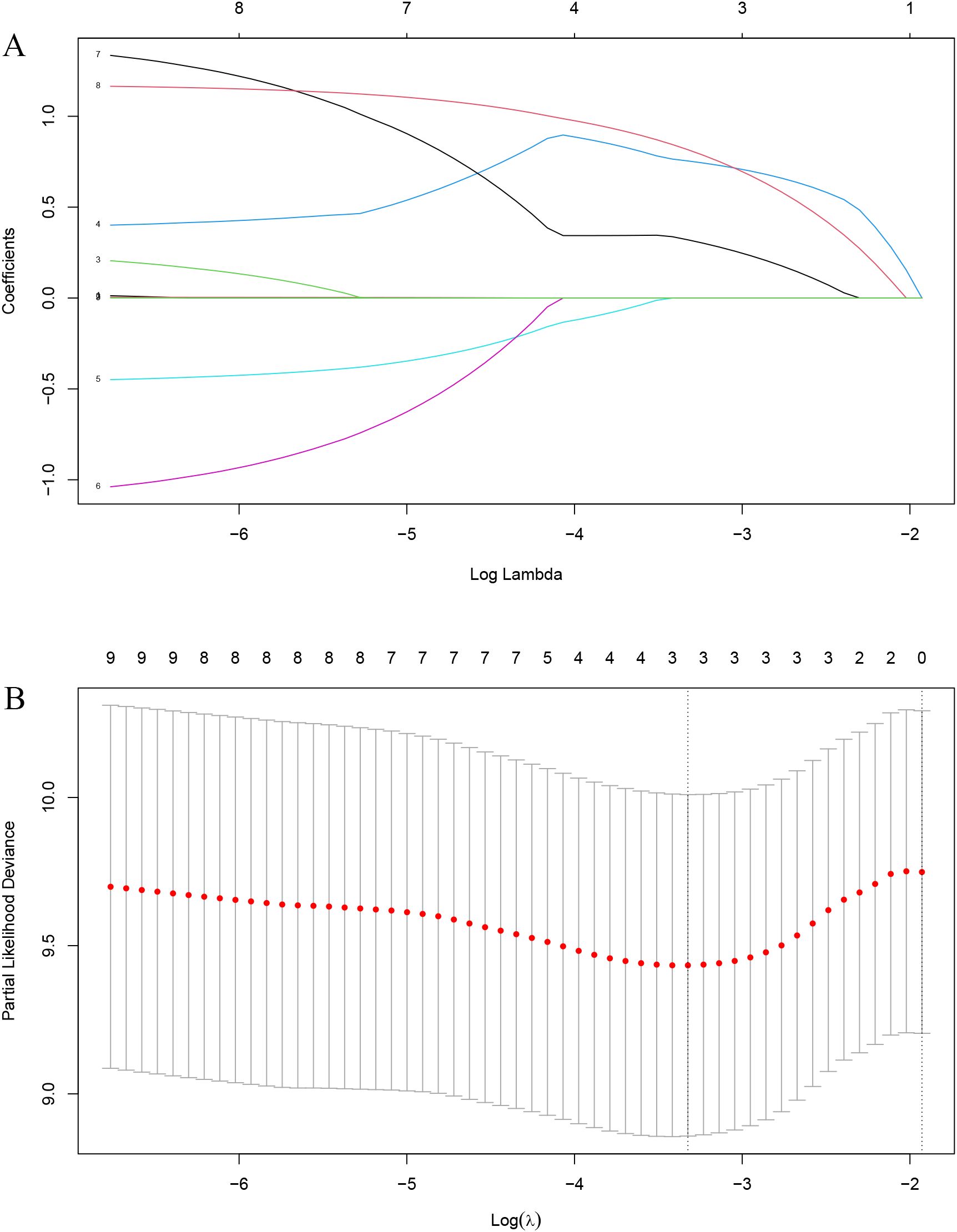
Figure 2. LASSO-Cox Regression Variable Selection Process. (A) The coefficient trajectories for variables versus log(λ). The dashed line marks the optimal λ selected via cross-validation. (B) The partial likelihood deviance versus log(λ), with error bars representing ±1 standard error.
Nomogram
Based on these two indicators, a nomogram was subsequently developed to predict 2-, 3-, and 5-year PFS (Figure 3). In the validation cohort, the nomogram achieved areas under the ROC curves (AUC-ROC) values of 0.801, 0.760, and 0.749 for predicting 2-, 3-, and 5-year PFS, respectively (Figure 4). Calibration (Figure 5A) and decision curves (Figure 5B) confirmed that the model demonstrated robust predictive performance.
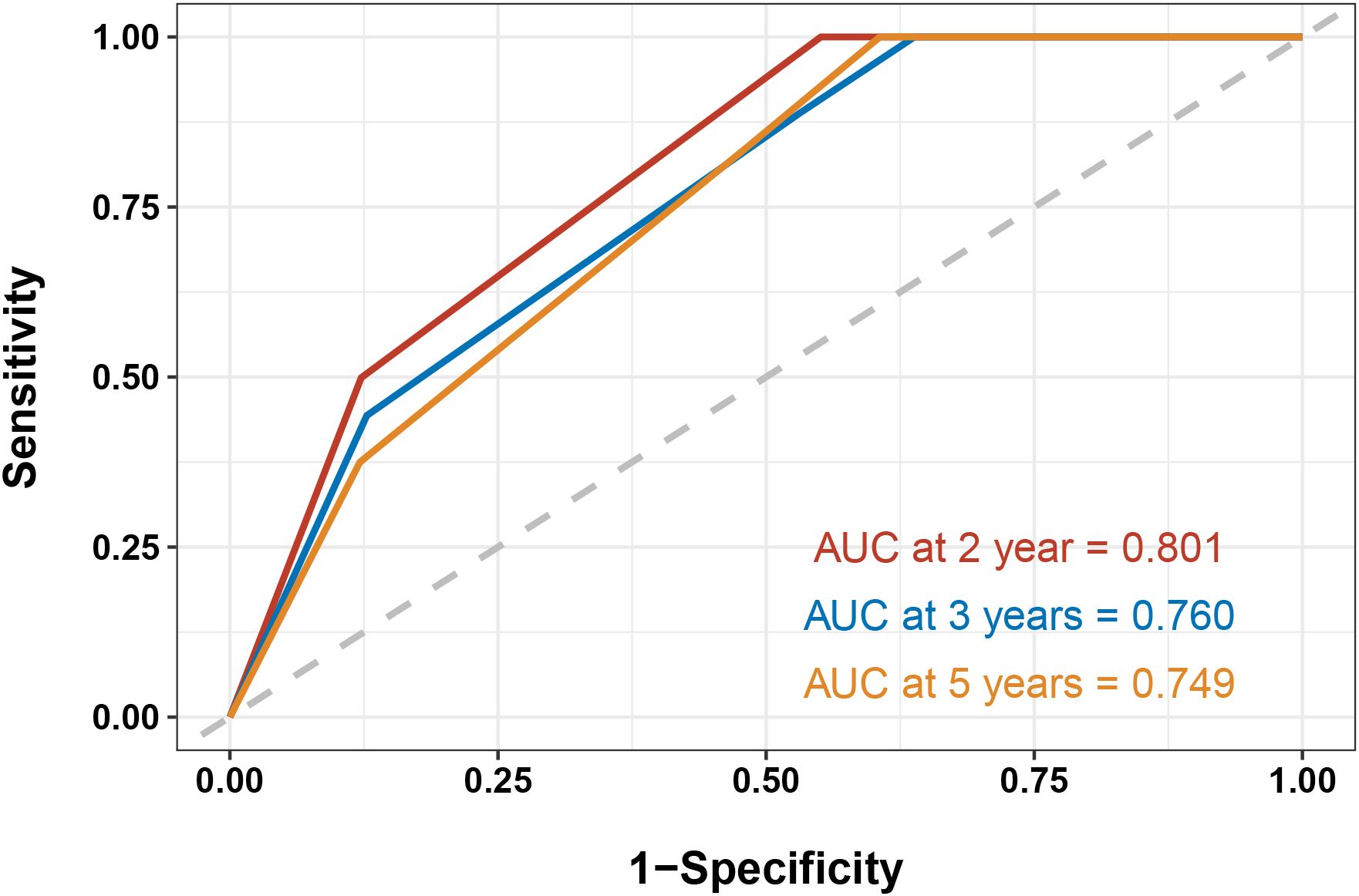
Figure 4. Receiver operating characteristic curves for predicting 2-, 3-, and 5-year progression-free survival in the validation cohort.
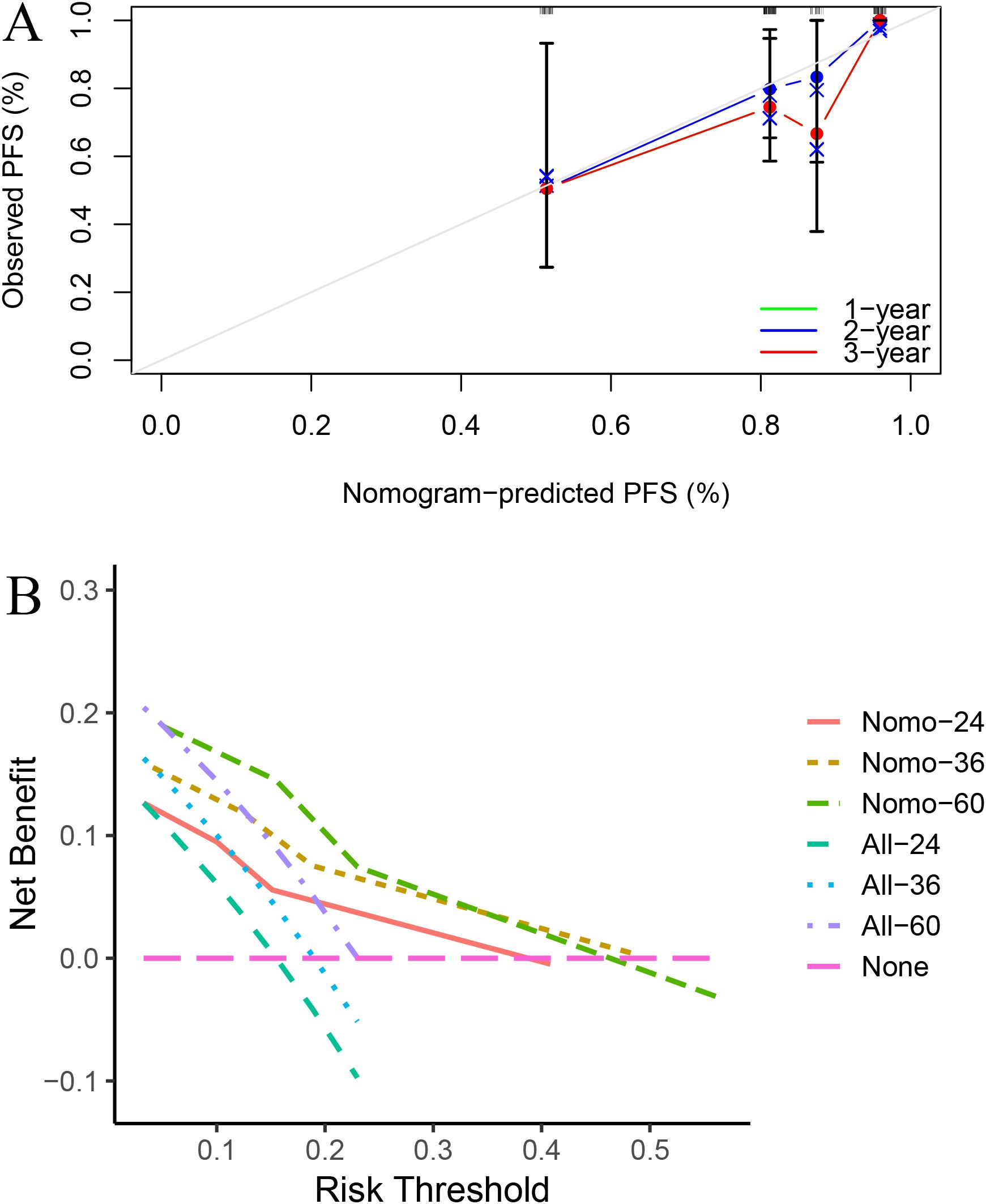
Figure 5. Calibration (A) and decision curves (B) confirmed that the model demonstrated robust predictive performance.
Discuss
In this study, we developed and validated a prognostic evaluation system for patients with lymph node metastatic NPC undergoing radiochemotherapy using a LASSO-Cox regression approach. Our analysis identified clinical stage and EBV level as independent prognostic indicators for PFS. Based on these factors, a nomogram was constructed, which demonstrated robust predictive performance in both the training and validation cohorts, with AUC-ROC values of 0.801, 0.760, and 0.749 for predicting 2-, 3-, and 5-year PFS, respectively.
The significance of radiotherapy in NPC management cannot be overstated. Radiotherapy, particularly with the advent of advanced techniques such as IMRT, has revolutionized the treatment of NPC. IMRT enables precise targeting of the tumor, delivering high doses of radiation while sparing adjacent normal tissues (14). This precision is critical given the proximity of NPC to essential structures in the head and neck region. Improved local control achieved through IMRT has led to enhanced survival outcomes and reduced treatment-related toxicities (15, 16). Despite these advances, variations in individual tumor radiosensitivity, radiation dose, and fractionation schedules still contribute to heterogeneous treatment responses, emphasizing the need for reliable prognostic tools that can guide personalized treatment plans.
Our findings underscore the complementary roles of traditional clinical staging and molecular markers in prognosticating NPC outcomes. Clinical stage has long been recognized as a cornerstone in oncologic evaluation, and our study reaffirms its importance in risk stratification. In addition, EBV level, a well-established biomarker in NPC, provides valuable insights into the tumor’s biological behavior. Elevated EBV levels may indicate a higher tumor burden or more aggressive viral activity, both of which are associated with poorer clinical outcomes (17, 18). The integration of these two factors into our prognostic model not only enhances its predictive accuracy but also offers a more comprehensive understanding of the disease process in NPC (19).
In clinical applications, interpretability is essential for ensuring that predictive models are both understandable and actionable by healthcare providers. The application of the LASSO method played a crucial role in managing high-dimensional data, allowing us to select the most relevant variables while mitigating issues of multicollinearity and overfitting (20). By combining LASSO with the Cox proportional hazards model, we were able to distill complex clinical and molecular information into a concise, user-friendly nomogram (21). This tool provides a quantitative method for estimating an individual patient’s risk of disease progression over multiple time points, thereby supporting more informed and personalized treatment planning (22).
One of the advantages of using the LASSO-Cox approach lies in its ability to produce a sparse model by shrinking the coefficients of less informative variables to zero, thereby simplifying interpretation and reducing overfitting. This is particularly important in oncology, where clinicians must weigh multiple risk factors in decision-making. In our study, the LASSO method selected a minimal set of key predictors—clinical stage and EBV DNA level—both of which have strong biological relevance, making the final model more transparent and clinically meaningful.
The inclusion of EBV DNA level in our nomogram underscores its biological and clinical relevance in NPC. Epstein–Barr virus plays a pivotal role in the pathogenesis of nasopharyngeal carcinoma, particularly in endemic regions. Elevated circulating EBV DNA levels are believed to reflect higher tumor burden and are associated with increased tumor cell turnover, releasing more viral DNA into the bloodstream (23). Mechanistically, EBV can promote tumor progression by facilitating immune evasion, inducing genomic instability, and activating signaling pathways involved in cell proliferation and anti-apoptosis (24). Moreover, EBV-related oncogenesis is often accompanied by a pro-inflammatory tumor microenvironment, which may further promote tumor progression and metastasis. Clinically, pretreatment EBV DNA levels have been shown to correlate with advanced disease stage and inferior survival outcomes (25). Thus, monitoring EBV DNA not only serves as a reliable prognostic marker but also offers practical value in risk stratification, surveillance, and potentially tailoring therapy intensity—for instance, identifying high-risk patients who may benefit from escalated or adjuvant treatments.
The nomogram developed in this study offers several practical advantages. It provides clinicians with a visual tool to predict 2-, 3-, and 5-year PFS, which can be used to identify patients at high risk for disease progression. For instance, high-risk patients may be considered for more aggressive treatment strategies or closer follow-up, while low-risk patients might continue with standard therapeutic protocols, potentially avoiding unnecessary toxicity. In this way, the nomogram supports the principles of precision medicine by ensuring that treatment interventions are tailored to each patient’s unique risk profile (26).
Given that radiotherapy is the mainstay of NPC treatment, our nomogram’s ability to predict outcomes in the context of radiochemotherapy is particularly meaningful (27). The model can assist in optimizing radiation treatment plans by identifying patients who might benefit from radiochemotherapy. Such individualized approaches not only improve treatment efficacy but also contribute to better resource allocation and a reduction in adverse effects (28–33).
Our study also employed a robust validation strategy by randomly splitting the patient cohort into training and validation sets. The absence of significant baseline differences between these sets supports the generalizability of our findings. The high predictive accuracy observed in the validation cohort further reinforces the reliability of our nomogram across different patient populations and clinical settings. When compared with previous studies, our model demonstrates enhanced prognostic performance by integrating both clinical and molecular parameters, thereby bridging the gap between conventional clinical assessments and modern molecular profiling.
Despite the promising results, our study does have several limitations. First, the retrospective design introduces potential selection and information biases, as the analysis relies on historical data, which may be incomplete or inconsistent despite rigorous data standardization. Second, although our sample size is adequate for initial model development, it may not fully capture the heterogeneity of NPC observed in larger, multi-center populations. Future prospective studies involving larger cohorts are needed to further validate and refine the nomogram. Third, while our model incorporates several key clinical and molecular indicators, there remains the possibility that additional biomarkers or imaging parameters—such as genomic alterations or advanced radiologic features—could further improve prognostic accuracy. In addition, although the LASSO-Cox nomogram demonstrated strong discrimination and calibration in the internal validation cohort, these results were derived from a retrospective dataset within a limited number of institutions. As such, the generalizability of the model to broader populations and diverse clinical environments remains uncertain. Future studies should focus on validating this model in external, multicenter cohorts with varied demographic and clinical characteristics to ensure its robustness and clinical utility in real-world settings. Lastly, the selection of the regularization parameter in the LASSO method is critical; although cross-validation was used to optimize this parameter, different settings might yield slightly different results, necessitating further sensitivity analyses.
Conclusion
In summary, our study demonstrates that a prognostic model based on the LASSO-Cox framework—integrating clinical stage and EBV level—can effectively predict progression-free survival in NPC patients undergoing radiochemotherapy. The nomogram derived from this model is a practical tool for personalized risk assessment and treatment planning. By enabling early identification of high-risk patients, our approach holds promise for guiding therapeutic decisions and ultimately improving clinical outcomes. Future research should focus on validating this model in larger, prospective cohorts and exploring the incorporation of additional prognostic markers to enhance its predictive accuracy in the era of precision oncology.
Data availability statement
The original contributions presented in the study are included in the article/supplementary material. Further inquiries can be directed to the corresponding author.
Ethics statement
The studies involving humans were approved by Luzhou People’s Hospital (22w202501003). The studies were conducted in accordance with the local legislation and institutional requirements. Written informed consent for participation was not required from the participants or the participants’ legal guardians/next of kin in accordance with the national legislation and institutional requirements.
Author contributions
SL: Writing – original draft, Writing – review & editing. XZhe: Data curation, Writing – review & editing. XZha: Software, Writing – review & editing. GL: Methodology, Writing – review & editing. HZ: Formal Analysis, Writing – review & editing. YZ: Writing – review & editing, Visualization. DW: Writing – review & editing, Project administration.
Funding
The author(s) declare that financial support was received for the research and/or publication of this article. Luzhou Medical Association (2024-YXXM-013).
Conflict of interest
The authors declare that the research was conducted in the absence of any commercial or financial relationships that could be construed as a potential conflict of interest.
Generative AI statement
The author(s) declare that no Generative AI was used in the creation of this manuscript.
Publisher’s note
All claims expressed in this article are solely those of the authors and do not necessarily represent those of their affiliated organizations, or those of the publisher, the editors and the reviewers. Any product that may be evaluated in this article, or claim that may be made by its manufacturer, is not guaranteed or endorsed by the publisher.
References
1. Wang RZ, Zhu LR, Xu YC, Chen MW, Liang ZG, Chen KH, et al. Development and validation of a nomogram based on the different grades of cervical lymph node necrosis to predict overall survival in patients with lymph node-positive locally advanced nasopharyngeal carcinoma. Acad Radiol. (2025), S1076–6332(25)00147-3. doi: 10.1016/j.acra.2025.02.034
2. Zhang Z, Chen X, and Yuan T. Precision radiotherapy for nasopharyngeal carcinoma. Prec Radiat Oncol. (2024) 8:37–41. doi: 10.1002/pro6.1219
3. Lv W, Chen Y, Hong W, Lan L, Chen J, Guo F, et al. Biomimetic gd-metal-organic framework radiosensitizer for near-infrared fluorescence imaging-guided radiotherapy toward nasopharyngeal carcinoma. ACS Omega. (2024) 9:38272–83. doi: 10.1021/acsomega.4c06191
4. Alterio D, D’Ippolito E, Vischioni B, Fossati P, Gandini S, Bonora M, et al. Mixed-beam approach in locally advanced nasopharyngeal carcinoma: IMRT followed by proton therapy boost versus IMRT-only. Eval toxicity efficacy. Acta Oncol. (2020) 59:541–8. doi: 10.1080/0284186X.2020.1730001
5. Dechaphunkul T, Ngamphaiboon N, Danchaivijitr P, Jiratrachu R, Geater SL, Pattaranutaporn P, et al. Benefits of prophylactic percutaneous gastrostomy in patients with nasopharyngeal cancer receiving concurrent chemoradiotherapy: A multicenter analysis. Am J Otolaryngol. (2022) 43:103356. doi: 10.1016/j.amjoto.2021.103356
6. Yu YF, Zhou P, Zhou R, Lin Q, and Wu SG. Lobaplatin-based concurrent chemoradiotherapy in elderly nasopharyngeal carcinoma. Ann Med. (2024) 56:2383959. doi: 10.1080/07853890.2024.2383959
7. Yang H, Liu C, Luo S, Ma R, Zhou Y, Yin Y, et al. Prognostic analysis of 152 patients with distant metastasis after intensity-modulated radiotherapy for nasopharyngeal carcinoma. Ann Palliat Med. (2021) 10:6824–32. doi: 10.21037/apm-21-1279
8. Lu N, Qin T, and Hu W. Impact of changes in psychological resilience during treatment with intensity-modulated radiotherapy on nasopharyngeal carcinoma patients: a prospective study. Ann Palliat Med. (2022) 11:123–34. doi: 10.21037/apm-21-3592
9. Ni W, Qi W, Xu F, Cao W, Xu C, Chen J, et al. Prognostic value of nasopharynx tumour volume in local-regional advanced nasopharyngeal carcinoma. Ann Transl Med. (2020) 8:223. doi: 10.21037/atm.2020.01.03
10. Fu XB, Li TT, Fei ZD, and Chen CB. Role of PET/CT in improving the cost effectiveness of nimotuzumab in nasopharyngeal carcinoma. Acta Otorhinolaryngol Ital. (2024) 44:296–305. doi: 10.14639/0392-100X-N2827
11. Chen S, Huang H, Liu Y, Lai C, Peng S, Zhou L, et al. A multi-parametric prognostic model based on clinical features and serological markers predicts overall survival in non-small cell lung cancer patients with chronic hepatitis B viral infection. Cancer Cell Int. (2020) 20:555. doi: 10.1186/s12935-020-01635-8
12. Lu N, Zhang WJ, Dong L, Chen JY, Zhu YL, Zhang SH, et al. Dual-region radiomics signature: Integrating primary tumor and lymph node computed tomography features improves survival prediction in esophageal squamous cell cancer. Comput Methods Programs Biomed. (2021) 208:106287. doi: 10.1016/j.cmpb.2021.106287
13. Chen JW, Shen RN, Zhu JQ, Wang YH, Fu LM, Chen YH, et al. Transcriptomic profiling reveals mechanism, therapeutic potential, and prognostic value of cancer stemness characteristic in nasopharyngeal carcinoma. Funct Integr Genomics. (2025) 25:56. doi: 10.1007/s10142-025-01561-w
14. Mongioj V, Orlandi E, Palazzi M, Deponti E, Marzia F, Stucchi C, et al. Set-up errors analyses in IMRT treatments for nasopharyngeal carcinoma to evaluate time trends, PTV and PRV margins. Acta Oncol. (2011) 50:61–71. doi: 10.3109/0284186X.2010.509108
15. Yang ZC, Du CC, Liu LT, Liang YJ, Tang LQ, Chen QY, et al. The prognostic role of plasma epstein-barr virus DNA levels in the middle of intensity modulated radiation therapy to guide cisplatin dose recommendation in concurrent chemoradiation therapy in patients with locally advanced nasopharyngeal carcinoma: A large cohort study. Adv Radiat Oncol. (2022) 7:100908. doi: 10.1016/j.adro.2022.100908
16. Yang K, Xie W, Zhang X, Wang Y, Shou A, Wang Q, et al. A nomogram for predicting late radiation-induced xerostomia among locoregionally advanced nasopharyngeal carcinoma in intensity modulated radiation therapy era. Aging (Albany NY). (2021) 13:18645–57. doi: 10.18632/aging.203308
17. Chen L, Yin J, Chen Y, and Zhong J. Induction of Epstein-Barr virus lytic replication by recombinant adenoviruses expressing the zebra gene with EBV specific promoters. Acta Biochim Biophys Sin (Shanghai). (2005) 37:215–20. doi: 10.1111/j.1745-7270.2005.00032.x
18. Yang S, Chen R, Wu Y, Song X, Peng X, and Chen M. Fluorinated polyethyleneimine vectors with serum resistance and adjuvant effect to deliver LMP2 mRNA vaccine for nasopharyngeal carcinoma therapy. Acta Biomater. (2025) 192:340–52. doi: 10.1016/j.actbio.2024.12.022
19. Schiess E, Jensen KH, Kristensen MH, Johansen J, Eriksen JG, Maare C, et al. Epidemiology and treatment outcome of nasopharyngeal carcinoma in a low-incidence population - a DAHANCA analysis in Denmark 2000-2018. Acta Oncol. (2024) 63:850–7. doi: 10.2340/1651-226X.2024.40499
20. He X, Xue N, Liu X, Tang X, Peng S, Qu Y, et al. A novel clinical model for predicting Malignancy of solitary pulmonary nodules: a multicenter study in chinese population. Cancer Cell Int. (2021) 21:115. doi: 10.1186/s12935-021-01810-5
21. Chen Y, Chen D, Wang R, Xie S, Wang X, and Huang H. Development and validation of a nomogram to predicting the efficacy of PD-1/PD-L1 inhibitors in patients with nasopharyngeal carcinoma. Clin Transl Oncol. (2024) 26:2601–7. doi: 10.1007/s12094-024-03504-6
22. Mao Y, Ding M, Zong D, Mu Z, and He X. Predicting radiation-induced hypothyroidism in nasopharyngeal carcinoma patients using a deep learning model. Clin Transl Radiat Oncol. (2025) 52:100946. doi: 10.1016/j.ctro.2025.100946
23. Hsieh HT, Zhang XY, Wang Y, and Cheng XQ. Biomarkers for nasopharyngeal carcinoma. Clin Chim Acta. (2025) 572:120257. doi: 10.1016/j.cca.2025.120257
24. Tan R, Zhu X, Sun Y, Yang S, Peng C, Feng X, et al. The association of HBV infection and head and neck cancer: a systematic review and meta-analysis. BMC Cancer. (2024) 24:225. doi: 10.1186/s12885-024-11967-7
25. Ye YF, Xiang YQ, Fang F, Gao R, Zhang LF, Xie SH, et al. Hepatitis B virus infection and risk of nasopharyngeal carcinoma in southern China. Cancer Epidemiol Biomarkers Prev. (2015) 24:1766–73. doi: 10.1158/1055-9965.EPI-15-0344
26. Gong MJ, Lai ZG, Zhang YX, and Hu N. Risk factor analysis and development of predictive models for osteoradionecrosis in patients with nasopharyngeal carcinoma after concurrent chemoradiotherapy. Am J Cancer Res. (2024) 14:4760–71. doi: 10.62347/RIWX7204
27. Li Z, Li C, Yang D, Zhou Z, and Kang M. Nomogram to predict long-term overall survival and cancer-specific survival of radiotherapy patients with nasopharyngeal carcinoma. BioMed Res Int. (2023) 2023:7126881. doi: 10.1155/2023/7126881
28. Liao W, Zhao Y, and Zhang S. The evolution of prophylactic neck irradiation in nasopharyngeal carcinoma: Changing concepts and irradiation ranges. Prec Radiat Oncol. (2025) 9:61–68. doi: 10.1002/pro6.70007
29. Yang L, Xia L, Wang Y, He S, Chen H, Liang S, et al. Development and external validation of nomograms to predict the risk of skeletal metastasis at the time of diagnosis and skeletal metastasis-free survival in nasopharyngeal carcinoma. BMC Cancer. (2017) 17:628. doi: 10.1186/s12885-017-3630-9
30. Wu S, Yuan X, Huang H, Li Y, Cui L, Lin D, et al. Nomogram incorporating Epstein-Barr virus DNA and a novel immune-nutritional marker for survival prediction in nasopharyngeal carcinoma. BMC Cancer. (2023) 23:1217. doi: 10.1186/s12885-023-11691-8
31. Wang Y, Jian W, Yuan Z, Guan F, and Carlson D. Deep learning with attention modules and residual transformations improves hepatocellular carcinoma (HCC) differentiation using multiphase CT. Prec Radiat Oncol. (2025) 9:13–22. doi: 10.1002/pro6.70003
32. Hua X, Xu F, Shi W, Long ZQ, Huang X, Duan FF, et al. Prognostic significance of platelet-to-albumin ratio in patients with nasopharyngeal carcinoma receiving concurrent chemoradiotherapy: a retrospective study of 858 cases. BMC Cancer. (2024) 24:762. doi: 10.1186/s12885-024-12499-w
Keywords: LASSO-Cox, nasopharyngeal carcinoma, radiochemotherapy, nomogram, lymph node metastatic
Citation: Lu S, Zhang X, Zheng X, Li G, Zhang H, Zhong Y and Wang D (2025) LASSO-Cox model in the prognostic evaluation of radiochemotherapy efficacy for lymph node metastatic nasopharyngeal carcinoma. Front. Oncol. 15:1606967. doi: 10.3389/fonc.2025.1606967
Received: 06 April 2025; Accepted: 16 May 2025;
Published: 04 June 2025.
Edited by:
Ke Su, Chinese Academy of Medical Sciences and Peking Union Medical College, ChinaReviewed by:
Linhan Jiang, Air Force Medical University, ChinaHexin Duan, Jishou University First Affiliated Hospital, China
Copyright © 2025 Lu, Zhang, Zheng, Li, Zhang, Zhong and Wang. This is an open-access article distributed under the terms of the Creative Commons Attribution License (CC BY). The use, distribution or reproduction in other forums is permitted, provided the original author(s) and the copyright owner(s) are credited and that the original publication in this journal is cited, in accordance with accepted academic practice. No use, distribution or reproduction is permitted which does not comply with these terms.
*Correspondence: Daijie Wang, bWVldGxxQG91dGxvb2suY29t
 Simin Lu
Simin Lu Xin Zhang
Xin Zhang Xin Zheng
Xin Zheng Gang Li
Gang Li